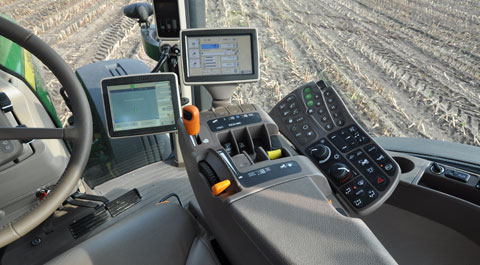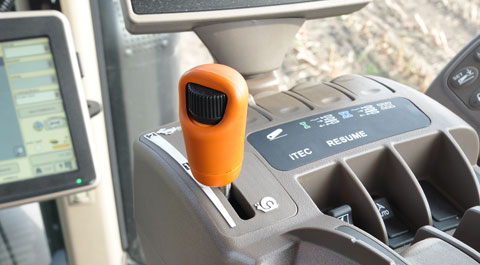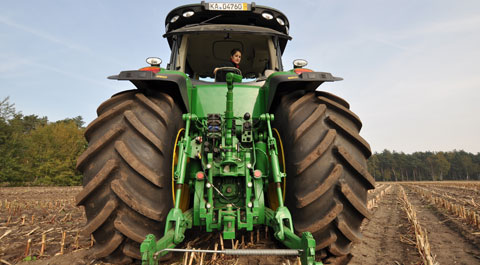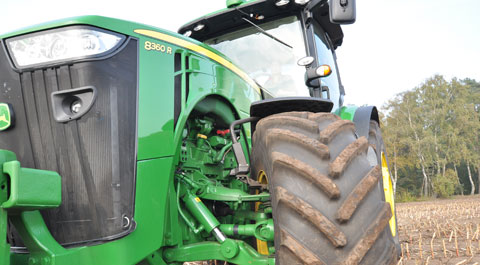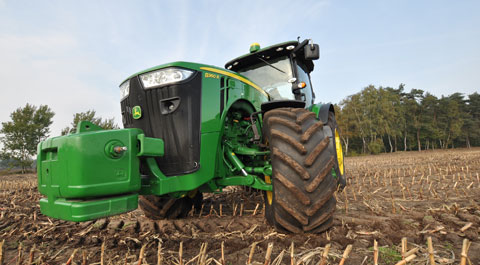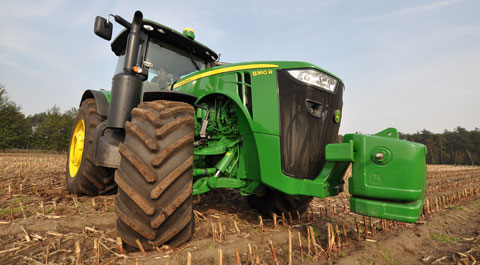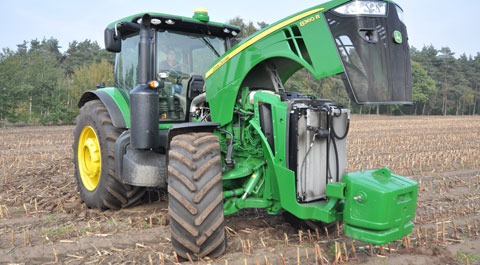Top-end tractor test: John Deere 8360R
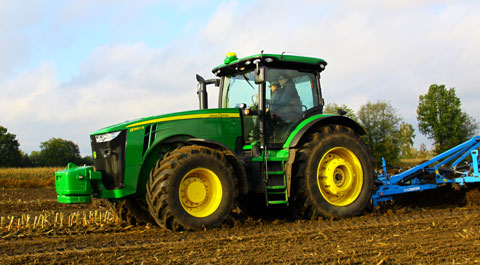
In terms of economy, test results didn’t quite match those of the JD 8335R. But they certainly weren’t bad, particularly as there wasn’t a drop of AdBlue used. Transmission is especially easy to operate. Cab ergonomics and driving comfort on the road is truly excellent. Base price £196,214
Steep steps lead up to the roomy, quiet (72dBA) well-finished cab. There’s no multifunction lever or joystick but Deere’s well-organised armrest controls more than compensate for this.
We scored the CommandCenter computer highly – it had a very clear display, a touchscreen and keys for direct access, as well as a rotary dial control. Touching an icon takes you through to the relevant set-up screen.
The menu operation is clear and settings can be made by button or fingertip. A password-protected page can be used to lock various functions – such as setting a speed limit – if inexperienced operators take to the seat.
There is no regular central dash, instead everyday things including gear selection, fuel level and engine temperature are handled by digital displays on the right-hand cab post – not easy to see in strong sunlight.
A total of 22 worklights (several of which are xenon) mean top-specced Deeres live up to the company’s claim of 360deg illumination. However, selecting individual lamps means delving into the computer system.
While the bonnet hides the front weights, the wasp-waist design, high seating position and thin cab pillars make for good views. A washer on the right-hand window would have been a good idea, as without a ladder it’s almost impossible to clean it. The telescopic electric mirrors are a real bonus, though.
SCORE: 4.5/5
Driving comfort
Our tractor had no accelerator pedal, but it was still comfortable to drive on the road. The active seat compensated for the lack of cab suspension.
The independent wishbone-type suspension on the front axle was effective, too. At 14.1m, the turning circle was the largest in the test.
We were also able to drive an 8360R with JD’s new ActiveCommand steering. The sensor-controlled steering adjusts steering angle and power according to speed.
If the tractor is travelling quickly, the steering is geared so that more movement is needed to avoid obstacles. If you’re driving slowly, for instance up to a junction, only a few turns are required for full lock. The variable gearing system is also very practical in the field.
SCORE: 4.5/5
Deere’s big-capacity 9.0-litre PowerTech engine, with its twin turbos, cooled exhaust recirculation and particulate filter, helps it meet Stage 3b emissions rules without AdBlue.
On the test rig the engine performed well, although it didn’t quite manage to achieve the same frugality as its smaller, powershift-equipped sibling, the 8335R.
With boost, the 8360R delivered up to 364hp at the pto, burning diesel at a rate of 235g/kWh – about 7g/kWh above the average.
However, no AdBlue was required, while the others consumed urea at a rate of 20-25g/kWh.
In the six-point, partial-load test the big Deere achieved the highest consumption at 239g/kWh (under boost) – 10g more than the best (Fendt) – but without the 26g/kWh AdBlue consumed by the Vario 939.
But where the 8360R excelled was in heavy draft work. With 309hp of raw pulling power, specific consumption totalled 264g/kWh – 2g/kWh under the average for all the stepless drive tractors. By comparison, the smaller powershift-equipped 8335R sipped just 252g/kWh in the same test – that’s about 5% less.
We missed not having engine speeds presets – there’s just an adjustable throttle limiter instead.
The boost facility (available for pto work or for speeds above 22.5kph) has to be switched on and off via the CommandCenter computer next to the driver. Engine loading can also be monitored and it’s possible to check whether the particulate filter is burning freely.
DPF regeneration takes place every 25 hours, though you’ll struggle to notice it (the DLG calculated this increases fuel use by between 0.3% and 0.4%).
SCORE: 4/5
We think Deere’s AutoPowr CVT set-up is the simplest system on the market and we particularly like the simple-to-fathom stick and its two-notch slot. The thumbwheel makes fine-tuning a doddle and, unlike other makes’ nudge-it-and-hope joysticks, you know exactly where you are, because it stays where you left it in the slot.
However, there isn’t really the option to drive it like a hydrostat. The closest you’ll get is to select your target speed and use the hand-throttle to vary how fast you actually go.
The tractor could also benefit from having a pedal function where speed and engine rpm are automatically controlled, depending on the weight of your right boot.
There are many opportunities for adjustment, however. Under lighter loads the fully automatic CVT aims to save fuel; for heavier draft work it endeavours to maximise power. And, for pto work, it sets out to maintain a steady engine rpm.
These three modes catered more than adequately for our practical test tasks, requiring very little fiddling with. However, for further fine-tuning there are what Deere calls “user-defined adjustments” to be found in the computer.
Or the operator can simply switch to straightforward manual mode, where the throttle controls the engine and the gearstick handles the transmission.
Forwards/reverse ratios are set a little unconventionally – a 10kph forward speed results in backwards travel at just 3kph.
The column-mounted shuttle lever has a clear parking lock and a neutral position.
SCORE: 4/5
Driveline
Tyre diameter is limited to 2.05m (MF and others can accommodate 2.15 m) – a disadvantage for heavy draft work. Four-wheel drive automation operates according to speed only (off at 20.5kph, on at 19.5kph).
With the diff-lock there’s only the trademark Deere foot button and no automation. Anyone wanting more than this has to programme the headland management system.
SCORE: 3/5
The front linkage is a bolt-on affair and there’s no true position control up in the cab – it’s run via a spool-valve. It’s a physically bulky set-up that protrudes well forward of the front axle.
The small rear-linkage paddle-switch combines up and down functions with depth control. You pull it up or down and then hold a button to store the set depth. It’s a matter of taste – many drivers prefer the classic rotary control for depth positioning.
But the button function proves itself when hitching up implements, because it works like the external controls.
With a 10t lift capacity and 80cm range, the big Deere can handle pretty much any mounted implement. The rated load capacity of 5.7t is pretty good. However, the unladen test tractor was more than 12t.
The test machine came with four hydraulic valves with fingertip control. Timing and flow settings are accessed very simply via the monitor.
At 240 litres/min, oil output is impressive, but there is only 25 litres available in total – that’s not really enough. We’d recommend going for the option of a 50-litre reserve.
SCORE: 4/5
The 8360R only has a single-speed 1,000rpm pto (a 540rpm version, with an interchangeable stub-shaft, is available ex-works). Pto automation is only available via the headland management system.
The external controls must first be activated via the computer, which isn’t the most practical way of doing things.
SCORE: 2.5/5
John Deere 8360R – test results
| 8360R | Stepless group average | |
|---|---|---|
| Max power | 364hp | 356hp |
| Fuel consumption (6-point test) | 239g/kWh (no AdBlue) | 234g/kWh |
| Fuel consumption at max draft power | 264g/kWh (no AdBlue) | 269g/kWh |
| Max linkage lift | 9.9t | 9.8t |
| Max hydraulic power | 240 litres/min | 207 litres/min |
| Load capacity | 5.7t | 5.1t |
| Turning circle | 14.1m | 13.5m |
LIKES
- Respectable engine performance, without AdBlue
- Simple, clear operating controls – excellent monitor
- Very comfortable ride
- Good build quality
GIPES
- No real engine speed presets
- Maximum tyre diameter is 2.05m
- Many automatic functions only available through headland management
- Heavy unladen weight
More tractor tests
| STEPLESS | POWERSHIFT |
|---|---|

